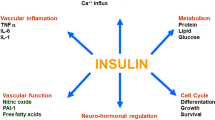Abstract
Background/aim
To study the characteristics of interleukin 6 (IL6), soluble form of interleukin 6 receptor (sILR)/IL6 complex in obese children and adolescents and its relationship with insulin resistance (IR).
Subjects and methods
66 obese children and adolescents [34 boys, mean age 10.3 ± 2.9 years, z-score of body mass index (BMI) 4.76 ± 1.36] and 24 non-obese healthy sex- and age-matched controls. Fasting levels of glucose, insulin, IL6, sIL6, sgp130 were measured. IR was assessed by homeostasis model assessment of IR (HOMA-IR).
Results
Obese subjects showed increased levels of insulin and IL-6 and higher HOMA-IR compared to controls (117.67 ± 50.9 vs. 62.42 ± 29.4 pmol/L, 2.73 ± 0.98 vs. 1.07 ± 0.41 pg/ml and 4.03 ± 2.16 vs. 1.83 ± 1.05 for insulin, IL-6 and HOMA-IR, respectively, p < 0.01 in all cases). sIL-6R levels were significantly lower in obese subjects (34.7 ± 14.2 vs. 55.6 ± 15.2 ng/ml in controls, p = 0.005), whereas sgp130 levels were not significantly different. In obese subjects, IL-6 directly correlated with z-score BMI (r = 0.481, p = 0.009) and with waist-to-height ratio (r = 0.494, p = 0.007), while sIL6-R was inversely related to HOMA-IR (r = −0.522, p = 0.002). Insulin resistant subjects showed higher levels of IL6 and lower levels of sIL6R (3.31 ± 0.72 vs. 2.25 ± 0.64 pg/ml, p = 0.020 and 25.3 ± 9.3 vs. 42.5 ± 10.4 ng/ml, p = 0.013, respectively).
Conclusions
In obese children and adolescents, IR is associated with elevated levels of IL-6 and diminished values of sIL-6R.



Similar content being viewed by others
Abbreviations
- BMI:
-
Body mass index
- HOMA-IR:
-
Homeostasis model of assessment-insulin resistance
- IR:
-
Insulin resistance
- IL-6:
-
Interleukin 6
- IL-6R:
-
Interleukin 6 receptor
- sIL-6R:
-
Soluble form of interleukin 6 receptor
References
Weiss R, Dziura J, Burgert TS et al (2004) Obesity and the metabolic syndrome in children and adolescents. N Engl J Med 350:2362–2374
Viggiano D, De Filippo G, Rendina D et al (2009) Screening of metabolic syndrome in obese children: a primary care concern. J Pediatr Gastroenterol Nutr 49:329–334
Senn JJ, Klover PJ, Nowak IA, Mooney RA (2002) Interleukin-6 induces cellular insulin resistance in hepatocytes. Diabetes 51:3391–3399
Galcheva SV, Iotova VM, Yotov YT, Bernasconi S, Street ME (2011) Circulating proinflammatory peptides related to abdominal adiposity and cardiometabolic risk factors in healthy prepubertal children. Eur J Endocrinol 164:553–558
Scheller J, Rose-John S (1997) Interleukin-6 family of cytokines. Annu Rev Immunol 15:797–819
Kallen KJ (2002) The role of transsignalling via the agonistic soluble IL-6 receptor in human diseases. Biochim Biophys Acta 1592:323–343
Schuett H, Luchtefeld M, Grothusen C et al (2009) How much is too much? Interleukin 6 and its signalling in atherosclerosis. Thromb Haemost 102:215–222
Weiss TW, Arnesen H, Selijefot I (2013) Components of the Interleukin-6 transsignalling system are associated with the metabolic syndrome, endothelial disfunction and arterial stiffness. Metab Clin Exp 62:1008–1013
Cole TJ, Lobstein T (2012) Extended international (IOTF) body mass index cut-offs for thinness, overweight and obesity. Pediatr Obes 7:284–294
Cole TJ (2002) A chart to link centiles of body mass index, weight and height. Eur J Clin Nutr 56:1194–1199
Mattews DR, Hosker JP, Rudeski AS et al (1985) Homeostasis model assessment: insulin resistance and β-cell function from fasting plasma glucose and insulin concentrations in man. Diabetologia 28:412–419
D’Annunzio G, Vanelli M, Pistorio A et al (2009) Insulin resistance and secretion indexes in healthy Italian children and adolescents: a multicentre study. Acta Biomed 80:21–28
Fernández-Real JM, Ricart W (2003) Insulin resistance and chronic cardiovascular inflammatory syndrome. Endocr Rev 24:278–301
Bastard JP, Maachi M, Lagathu C et al (2006) Recent advances in the relationship between obesity, inflammation, and insulin resistance. Eur Cytokine Netw 17:4–12
Vozarova B, Weyer C, Hanson K, Tataranni PA, Bogardus C, Pratley RE (2001) Circulating interleukin-6 in relation to adiposity, insulin action, and insulin secretion. Obes Res 94:14–417
Stith RD (1994) Luo J Endocrine and carbohydrate responses to interleukin-6 in vivo. Circ Shock 44:210–215
Petersen EW, Carey AL, Sacchetti M et al (2005) Acute IL-6 treatment increases fatty acid turnover in elderly humans in vivo and in tissue culture in vitro. Am J Physiol Endocrinol Metab 288:E155–E162
Bastard JP, Maachi M, Tran Van Nhieu J et al (2002) Adipose tissue IL-6 content correlates with resistance to insulin activation of glucose uptake both in vivo and in vitro. J Clin Endocrinol Metab 87:2084–2089
Mooney RA, Senn J, Cameron S et al (2001) Suppressors of cytokine signaling-1 and -6 associate with and inhibit the insulin receptor. A potential mechanism for cytokine-mediated insulin resistance. J Biol Chem 276:25889–25893
Matthews DR, Hosker JP, Rudenski AS, Naylor BA, Treacher DF, Turner RC (1985) Homeostasis model assessment: insulin resistance and β-cell function from fasting plasma glucose and insulin concentrations in man. Diabetologia 28:412–419
Reinehr T, Andler W (2004) Changes in the atherogenic risk factor profile according to degree of weight loss. Arch Dis Child 89:419–422
Keskin M, Kurtoglu S, Kendirci M, Atabek ME, Yazici C (2005) Homeostasis model assessment is more reliable than the fasting glucose/insulin ratio and quantitative insulin sensitivity check index for assessing insulin resistance among obese children and adolescents. Pediatrics 115:e500–e503
Acknowledgments
This study was supported by a grant of University of Foggia (Italy).
Conflict of interest
The authors declare that there is no conflict of interest that could be perceived as prejudicing the impartiality of the research reported.
Author information
Authors and Affiliations
Corresponding author
Additional information
G. De Filippo and D. Rendina contributed equally.
Rights and permissions
About this article
Cite this article
De Filippo, G., Rendina, D., Moccia, F. et al. Interleukin-6, soluble interleukin-6 receptor/interleukin-6 complex and insulin resistance in obese children and adolescents. J Endocrinol Invest 38, 339–343 (2015). https://doi.org/10.1007/s40618-014-0176-4
Received:
Accepted:
Published:
Issue Date:
DOI: https://doi.org/10.1007/s40618-014-0176-4




